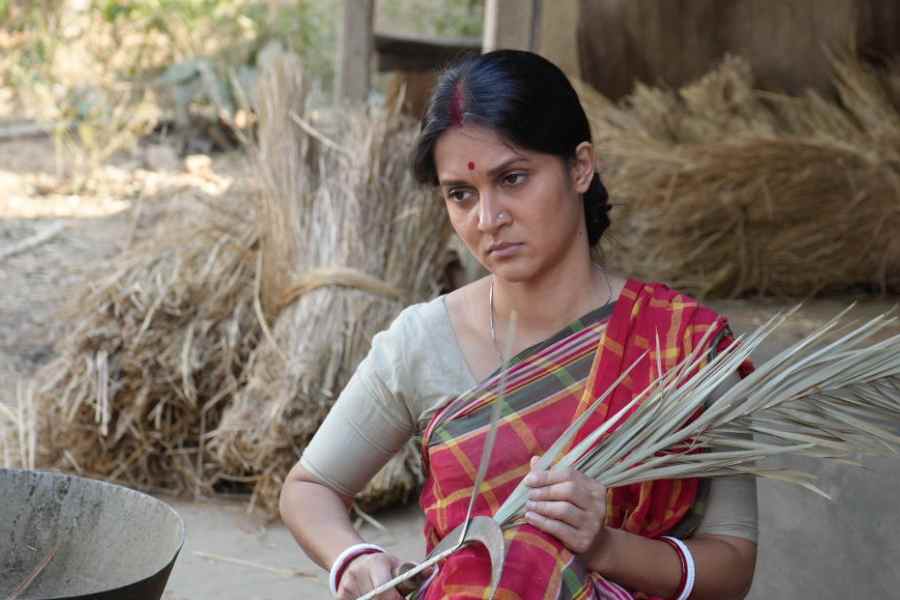Casteism and untouchability are the most potent weapons used through ages in India to divide, ostracise and dominate the masses by a few self-proclaimed (at one time) upper caste, rich individuals or groups. It is still rampant all over India, in certain states overtly and in others covertly. In the last 100 years, voices have been raised by men and women with a vision and compassion. One such was Bengal’s much-loved novelist Sarat Chandra Chattopadhyay. His story Abhagir Swargo bears testimony. Written in around 1925, the story revolves around a low-caste woman’s desire to travel to heaven after death in a chariot, dressed in her marital fineries. Her desire for the same is intensified when she watches the zamindar’s wife’s cremation. The story has several layers, just as casteism is addressed so is patriarchy.
Anirban Chakrabarty had the gumption, and to some extent the guts, to adapt Abhagir Swargo and write a script that placed the story in the 1970s. In Bengal, untouchability and casteism are present but it is not that rampant. However, it is still a tool of oppression over the so-called ‘lower castes’ and especially women. Strange are the ways of the upper caste: you can get physical satisfaction from a woman of low caste yet she is not allowed to enter the haloed precincts of the temple.

Ishan Mazumder and Mithila Sourced by The Telegraph
Anirban's O Abhagi, though inspired by Sarat Chandra’s story, has new dimensions. The changing times and mores have been woven into the film’s fabric yet the age-old fantasies ingrained in women in India regarding their marital status and total subjugation to the husband, however indifferent or immoral he may be, are portrayed by both Mithila as Abhagi and Debjani as the zamindarin. Through death and subsequent rituals performed on Ginny Ma’s (zamindar’s wife) body before and during cremation, Abhagi fantasises about her death and witnesses a vision where decked in a red sari, with vermillion smeared forehead and alta-painted feet, the zamindarin floats towards the so-called heaven in a chariot.
Rafiath Rashid Mithila and Debjani Chatterjee in their portrayal of two women from two different stratas of society are believable in their gullibility and belief in the system. But somewhere there are moments when they want to be defiant but can only do so with Abhagi hallucinating about her meeting with Yamraj (God of Death) and the zamindar's wife through strict prayer rituals and devotion to her husband.
The sexually potent zamindar and Abhagi’s musician of a husband Rasik, dilly-dally with women who have been marginalised. A man’s character is never defiled through his sexual exploits, whereas for a woman everything is lost when she is touched and exploited by the man, whatever be his caste or position in society. Both Subrata Dutta as zamindar and RJ Sayan as Rasik are obnoxiously believable!
There is another aspect into which Anirban delves at length, which is a child’s (Kangali) devotion to his mother and his fight for the fulfilment of his mother’s last wish to go to heaven decked in her marital fineries. As the young teenager fights the system and decides to protest, one sees a ray of hope: the possibility of a change. You can push people up to a point but not beyond.
O Abhagi is supported by a good cast and a creative DOP, Maloy Mondal. The rural ambience and lighting pattern blended with reality and the principal characters’ makeup and costume, their dialogue throw was appropriate. Some of the actresses portraying women of ‘loose morals’ were a little jarring, as they tried too hard to be what they were not.
Krishna Banerjee as Keshto was as hateful as could be and Sourav Haldar as Kangali showed his mettle as a young artiste in the making. The music, foley and songs added to the film’s ambience. The economical use and blend of music, the songs by Rupankar Bagchi and Animesh Roy deserve special mention. Music director Mousumi Chatterjee has used all the voices appropriately, those of Lagnajita (Chakraborty), Chandrani (Banerjee) et al.
The spoken language of the film is totally un-Sarat Chandra-esque: major use of ‘cuss words’ and abusive language to some ears could sound too harsh, especially for those raised in a ‘bhadro’ atmosphere and with Victorian morals, who are either unaware or prefer to overlook the subaltern lingo. Anirban has come out of the mould of following the story to a T. He has put in his interpretation, added characters of his own and created nuances.
PS: A word of appreciation is due to the producer Dr Prabir Bhaumik for supporting an initiative of the young director.










